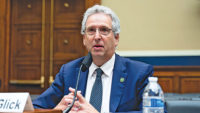With politics shifting on U.S. infrastructure investment in the wake of the November midterm results, public-private partnership participants offered differing perspectives last month in Washington, D.C., on how the project finance approach will fit into looming federal legislation and burgeoning state and local project funding needs.
Speakers at the P3 Federal Conference, held Nov. 27-28, noted the need to raise awareness of private finance options to newly elected officials as an infrastructure investment tool.
Dale Bonner, executive chairman of investment firm Plenary Concessions, said more than 60 private-finance projects are “in various forms of procurement,” with 100 others being considered for the approach.
“We need to get the conversation where it needs to be,” he said. “Infrastructure designed for the past is more vulnerable to climate change; even systems now operating fine will need upgrade or replacement.”
Keynoter DJ Gribbin, the former infrastructure advisor to the Trump Administration who now is senior operating partner at project developer Stonepeak Infrastructure Partners, said states and municipalities must consider new approaches, with uncertain federal funding ahead.
“We’re still in a 1956 mind-set as to the federal government’s role,” he said. “We need a different role to meet today’s needs. Most Americans don’t understand that the feds don’t own the federal highway system.”
Gribbin acknowledged the challenge of promoting infrastructure investment as an administration priority, with timing of promised federal legislation still uncertain. He noted his White House challenge in “getting the message to punch through. It was not seen as screamingly urgent.”
Gribbin said that recent moves by industry contractors such as Skanska USA and AECOM to exit P3 project investor roles due to risk concerns is a “market signal” of challenges in America’s private-finance arena on public projects, “but it doesn’t signal the death of P3s. As projects get bigger, new issues bubble up.”
Depressing?
But one design firm P3 executive termed Gribbin’s outlook for a very reduced federal financing role “depressing.”
She said his stance that “infrastructure funding is a local issue and states and municipalities will have to find their own funds … lacked the concept of ‘public good,’ which is a role of government. We never would have had the interstate highway system with [Gribbin’s] approach, which does not seem forward thinking about changes we need to make as a country to continue to compete globally.”
The executive added: “He spoke down to us as if we didn’t know the feds don’t have money to fund infrastructure. In fact, the industry knew his plan was dead on arrival when it was released before he left the administration [earlier this year].”
Joe Hockey, Australian ambassador to the U.S., noted the success of that country’s asset recycling program, under which public agencies lease existing infrastructure to private entities with fees used to invest in projects.
Between 2015 and 2017, the $3-billion program generated more than $17 billion in infrastructure spending, although only three of the country’s eight states participated. “Locals had to own the politics,” he said.
Hockey said the U.S. “has fallen behind the rest of the developed world in privatized assets … and will have to move more urgently on P3s than you realize,” noting the projected economic impact of lagging infrastructure investment “and trillions of dollars worth of underperforming assets.”
He noted, however, the U.S. “fixation” on governments owning assets and too few sell-side advisors to state and municipal owners. “Governments … need a formula to roll it out fast,” said Hockey.
Participants noted the particular U.S. challenge in P3s for environmental infrastructure, with private ownership of water and wastewater facilities generating a "fear factor," said Linda H. Bonner, operations manager of the Water Design-Build Council.
Baltimore voters last month approved a ballot measure to keep its water infrastructure publicly managed and funded, despite a $1.6-billion upgrade it must finance under an EPA consent decree.
Meanwhile, industry advocates hope post-election changes will spur P3 momentum.
Steve Hall, senior vice president at the American Council of Engineering Cos., noted efforts to fix a provision in the 2017 tax reform law—which he described as an "unintended consequence"—that limits interest deductibility, and could impact P3 value.
Others see larger issues ahead. “Our goal is to get the rhetoric into something that moves through Congress,” said Ed Mortimer, U.S. Chamber of Commerce vice president of transportation and infrastructure.
“Infrastructure is the only issue that Democrats and Republicans agree on.” He said in any legislation, “private investment has to be part of the mix, but it can’t replace federal investment.”






Post a comment to this article
Report Abusive Comment